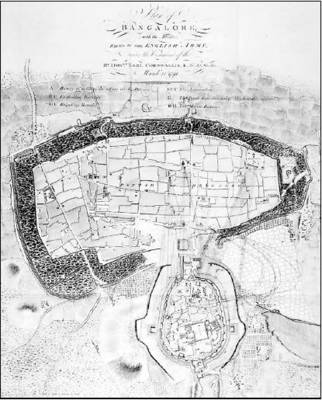Most Of Garden City Was Built Or Borrowed

The plan of Bangalore made in 1791 by the English Army under the command of Lord Cornwallis.
Bangalore landscape: less natural about it
New Research Reveals Most Of Garden City Was Built Or Borrowed
Times of India
Ever wondered how Bangalore became the Garden City or city of lakes? If you are looking for a physical history of Bangalore, here are some eye-openers.
A four-year intensive research covering five centuries shows almost everything in Bangalore’s landscape has been built or borrowed. Meaning, there is very little in Bangalore that could be called ‘of natural origin’ including our green belt, lakes, boundaries or popularity.
The researchers — Pennsylvanian landscape architects Anuradha Mathur and Dilip Da Cunha — have uncovered facts about Bangalore which, when made public, could make Bangalore the most history-rich tourist destination in India. Next perhaps, to Ajanta or Ellora in popularity. For a change, the city might draw in the monies not just because of its IT.
Try some appetisers. The British did not always call Bangalore ‘Pensioner’s Paradise’. Nor is our pride, the Rain Tree, really ours. Incidentally, Bangalore never had any lakes. All ‘lakes’ are in reality age old tanks — we had 104 in all. As it turns out, Bengaluru, believed to be designed by Kempegowda, did not have areas or tree plantations as is believed. A crude crossing point of Chikpet and Avenue Road was where Bangalore was born.
“But in the 1790s, Bangalore was already considered a global entity since we have found city maps dating back to this time in American University libraries,’’ Dilip says. Later, the British found Bangalore interesting only because of the very first name they gave it — ‘Terra Incognito’ or Naked Country. Ideally positioned for taking over Tipu Sultan. Records of a 1792 British battlemap of the Deccan designed by Lord Cornwallis has been found by Anuradha and Dilip.
Bangalore’s only trees were coconut, mango, peepal, date palms and a bound hedge around the city — a tradition of settlements south of Bellary. The Rain Tree was actually imported from Jamaica in 1870. All flowering and shade trees have come from Indonesia and Australia. Lalbagh was born from these seeds.
The research has included visits to old manufacturing places of Ganeshas and agarbattis, the Gavipuram mantap, the granite belt and Shivasamudram. “Bangalore has always been a constructed landscape but people have thought otherwise. This perception has created pessimism about the shrinking greenery and chaotic cityscape. In reality, everything was built before. It can be done again. If we understand this, we can find solutions to the bursting city seams,’’ Anuradha adds.
The duo are setting up an exhibit of all the documents, maps and research literature pointing to the making of Bangalore at Lalbagh from October 10. They have also shown interest in making this a permanent exhibition for tourists and school students interested in Bangalore’s history. Anuradha has co-authored ‘Mississippi Floods: Designing a Shifting Landscape’. She and Dilip believe that landscape is the core factor in the study of shifting phenomenon.
Sample these
• The Victoria Hospital is located in what was earlier a fort
• C.V. Raman Nagar and Indiranagar of today were where Tipu Sultan and Lord Cornwallis’ armies first met in 1791
• The only trace of the Bound Hedge is at the toll booths on major highways












0 Comments:
Post a Comment
<< Home